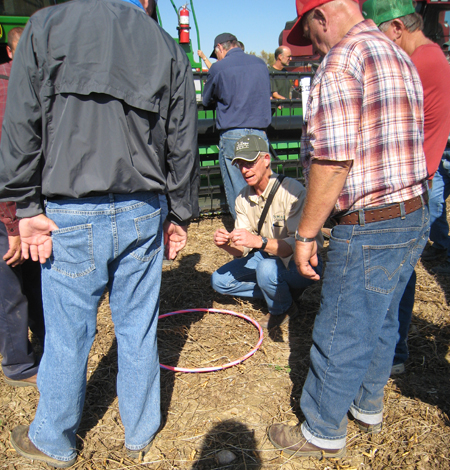How to identify soybean losses during harvest and make adjustments
If you’re losing four soybeans per square foot, you are losing about one bushel per acre. A recent field day highlighted methods for identifying and limiting losses during harvest.
Over 80 farmers gathered recently at George Zmitko’s farm to see the newest technology in harvesting equipment and learn how to evaluate their own harvest losses.
Here are a few of the tips shared for measuring losses.
Check for harvest loss just behind the header
Eighty percent of the loss is from gathering losses. If you stop the combine and back up about 15 feet, you won’t have to sort through the chaff to find the soybeans.
Build a one-foot square frame
Randomly drop the frame in at least four locations across the width of the head. Record soybean counts for each location. A hula-hoop can also be used, calculate the area using p (r)2 = area, where r = radius of circle in feet and p = 3.14159. Example: radius = 1.5 feet, so the area is 3.14159(1.5)2 = 7.07 ft2.

Mike Staton, MSU Extension soybean educator, demonstrates how to determine
harvest loss.
Categorize loss
Categorize loss by shatter loss in both standing beans and in the harvested area (some beans are on the ground before you get there with the combine), loose stalk loss, lodged stalk loss and stubble loss.
Assess the findings
Gathering this information gives producers an idea of where the losses are occurring. The patterns of loss as well as the number of soybeans recorded in each of the categories are all clues to what needs to be fixed, replaced or adjusted.
The goal is to reduce harvest losses to 3 percent. Regular assessment and adjustments will help producers reach that goal.
Many thanks to the sponsors that made the Soybean Harvest Equipment field day possible: Michigan State University Extension , Michigan Soybean Checkoff, Aldermans Incorporated, D&G Equipment, Inc. and Advanced Wind-Reel Systems.
For more information on how to document losses and make adjustments, see SMaRT Soybean Facts: Reducing Soybean Harvest Losses.



 Print
Print Email
Email


